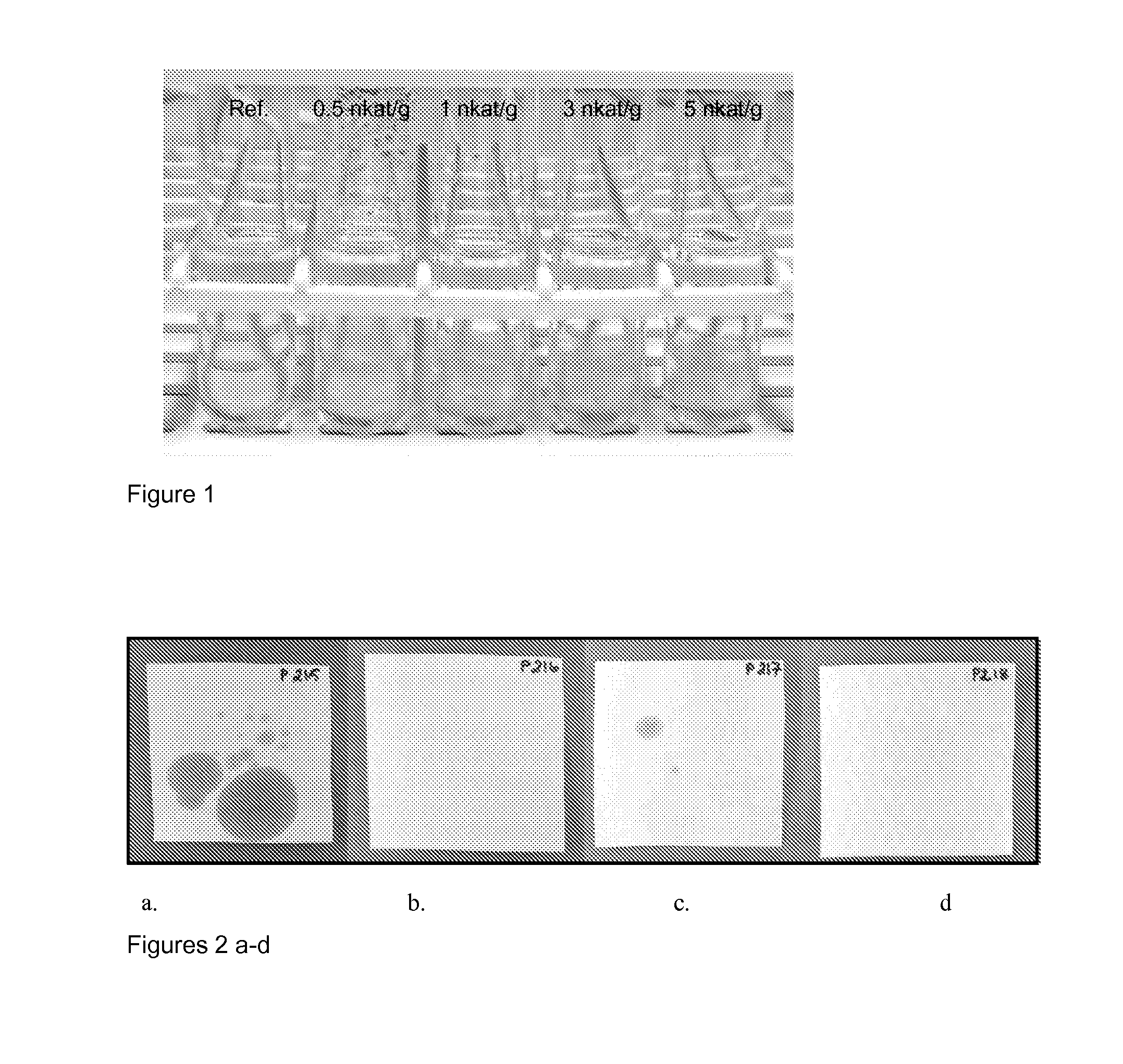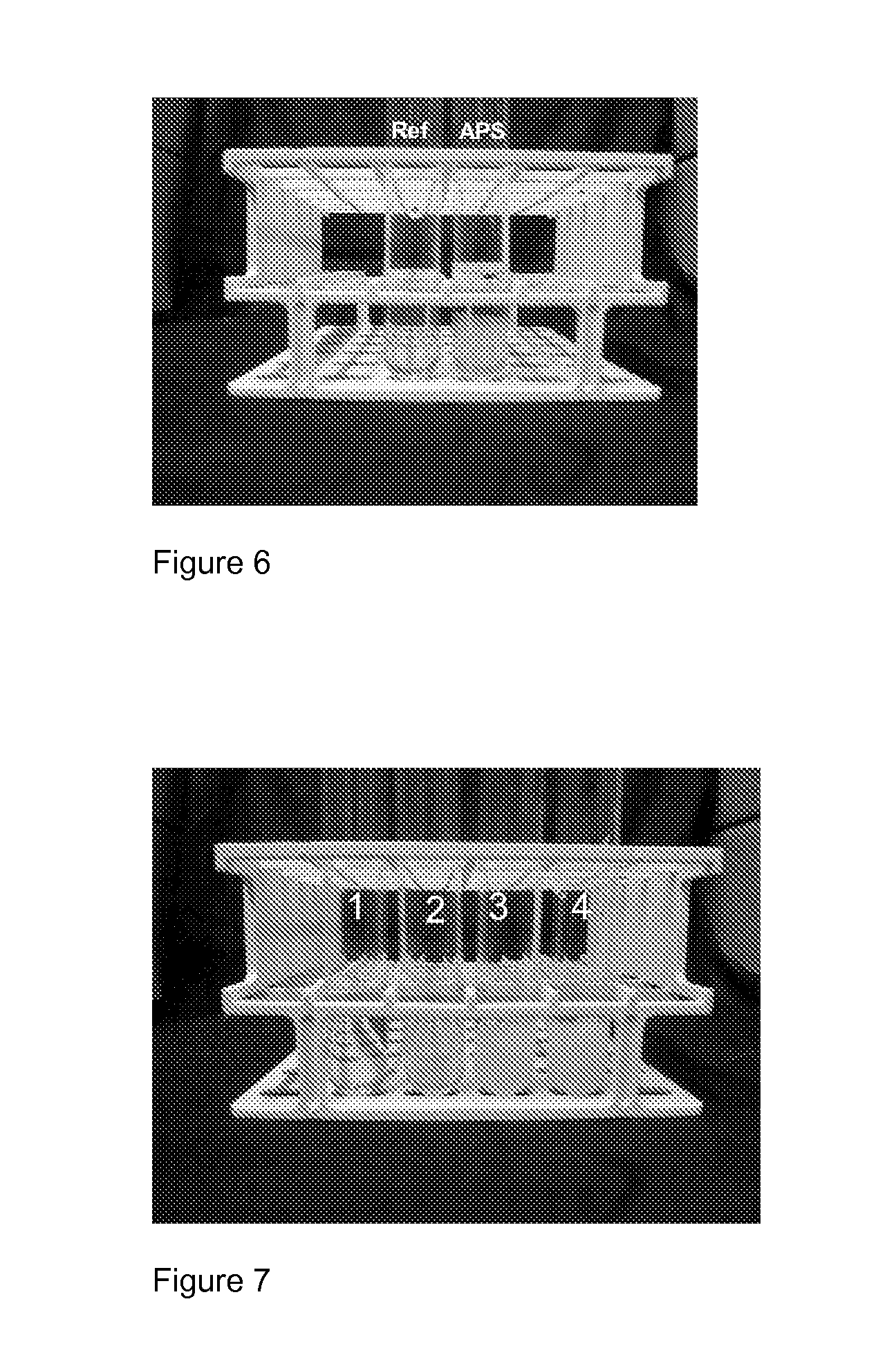Modified biomaterial, uses thereof and modification methods
a biomaterial and modified technology, applied in the field of biomass technology, to achieve the effect of improving the barrier properties and/or mechanical properties of the polymeric polysaccharide matrix
- Summary
- Abstract
- Description
- Claims
- Application Information
AI Technical Summary
Benefits of technology
Problems solved by technology
Method used
Image
Examples
example 1
PRODUCTION AND PURIFICATION OF THE ENZYMES
[0116]The Trametes hirsuta-laccase (ThL) was purified as follows. The culture filtrate from T. hirsuta strain VTT D-443 was concentrated by ultrafiltration (PCl, 25-kDA cut off). Salts were removed from the concentrate and the buffer changed to 15 mM acetate buffer pH 5.0 by gel filtration (Sephadex G 25; h=57 cm, V=18 l). The active fractions were pooled and the solution was concentrated again by ultrafiltration (PCl, 25-kDa cut off). The sample was applied to a DEAE Sepharose Fast Flow anion exchange column (h=29 cm, V=9 l), which was equilibrated with 15 mM sodium acetate pH 5.0. The proteins were eluted with a linear 0-200 mM NaCl gradient. Laccase eluted at 120-150 mM NaCl concentration. Positive fractions were pooled and Na2SO4 was added to the sample to final concentration of 1 M. The sample was applied to a Phenyl Sepharose Fast Folw hydrophobic interaction column (h=20 cm, V=400 ml) equilibrated with 20 mM citrate buffer pH 5...
example 2
CROSS-LINKING OF SUGAR BEET PECTIN
[0118]Sugar beet pectin was obtained from Danisco Sugar A / S. Some properties of the sugar beet pectin are shown in Table 1.
TABLE 1General properties and quality of the sugar beet pectinGeneral propertiesDry substance95.2%pH3.8Molecular weight31 500 g / molQualityPurity99.3%Galacturonic acid72.4%Acetic acid 5.3%Degree of methylation61.8%Degree of acetylation23.4%
[0119]The pectin solution (7% w / w) for stand alone films or coatings was prepared as follows: Pectin was dispersed into deionised water under mixing with a magnetic stirrer and glycerol (33.5%) was added. Glycerol was used as the plasticiser. The pectin solution was slightly heated up and pH was adjusted to 4.5 with 1 M NaOH. Degassing of the pectin solution was carried out with an ultrasonic bath prior to use for preparation of stand alone films or coating on card board in order to avoid gas bubbles and pin holes.
[0120]Cross-linking of pectin was catalysed by laccase. The treatments of pectin ...
example 3
KING AND FUNCTIONALIZATION OF SUGAR BEET PECTIN
[0123]Pectin solution was prepared as described in Example 2. Motivation for simultaneous cross-linking and functionalization of sugar beet pectin was to obtain insoluble pectin matrix with less hydrophilic nature in a one step treatment. Aquatic dispersion of dodecyl gallate (DOGA, Merck), octyl gallate (OGA, Lancaster), or aquatic solution of propyl gallate (PROGA, Acros) was used as hydrophobic agents. DOGA, OGA, or PROGA were added to the reaction mixture at the concentration of 10 or 20 mg / g of pectin.
[0124]Aqueous dispersions of DOGA and OGA were prepared as follows: 0.821 g DOGA (dodecyl 3,4,5-trihydroxybenzoate, Merck) or OGA (3,4,5-trihydroxybenzoic acid octyl ester), 0.08 fennodispo A41, 20 ml acetone and 20 ml distilled water were mixed in a beaker and heated until acetone was evaporated. After that a mixture containing 0.04g lecithin (L-α-P- from egg yolk, Fluka) in approximately 40 ml of water (60° C.) was added and the fin...
PUM
| Property | Measurement | Unit |
|---|---|---|
| temperatures | aaaaa | aaaaa |
| temperatures | aaaaa | aaaaa |
| pH | aaaaa | aaaaa |
Abstract
Description
Claims
Application Information
 Login to View More
Login to View More - R&D
- Intellectual Property
- Life Sciences
- Materials
- Tech Scout
- Unparalleled Data Quality
- Higher Quality Content
- 60% Fewer Hallucinations
Browse by: Latest US Patents, China's latest patents, Technical Efficacy Thesaurus, Application Domain, Technology Topic, Popular Technical Reports.
© 2025 PatSnap. All rights reserved.Legal|Privacy policy|Modern Slavery Act Transparency Statement|Sitemap|About US| Contact US: help@patsnap.com



